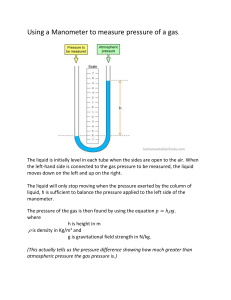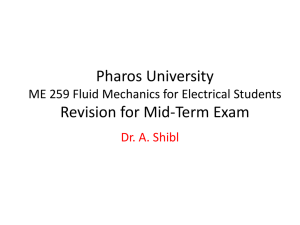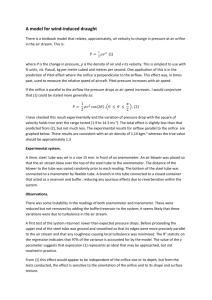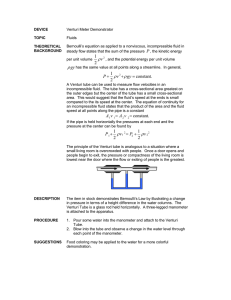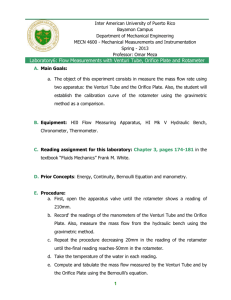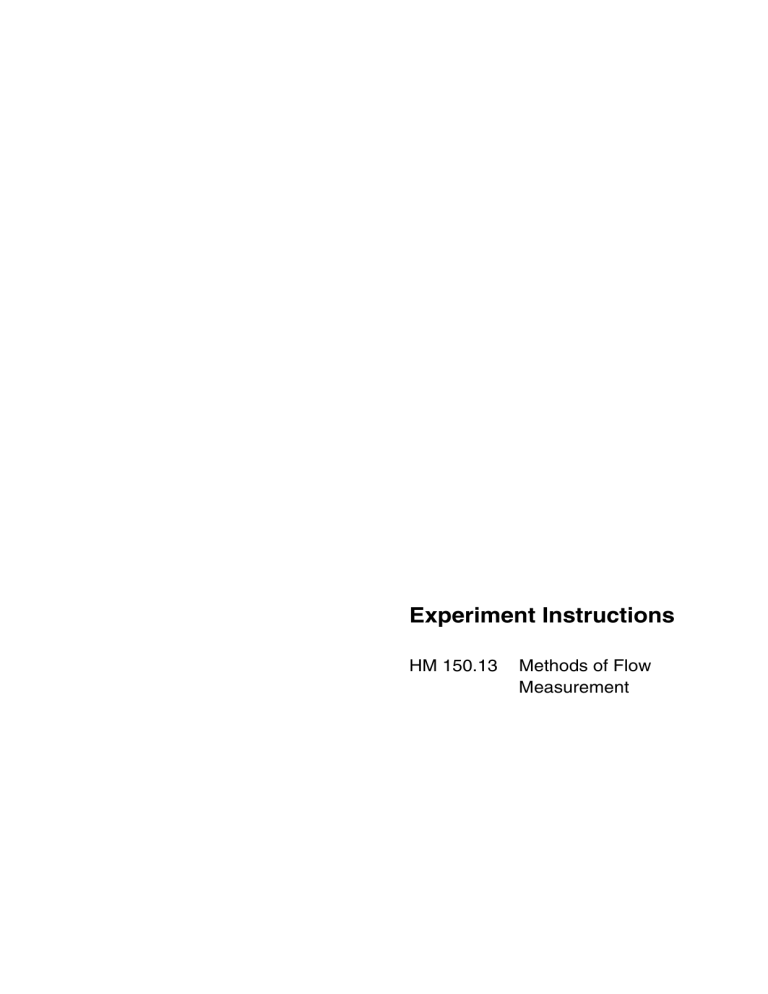
Experiment Instructions HM 150.13 Methods of Flow Measurement All rights reserved, G.U.N.T. Gerätebau, Barsbüttel, Germany 08/2012 HM 150.13 METHODS OF FLOW MEASUREMENT Experiment Instructions This manual must be kept by the unit. Before operating the unit: - Read this manual. - All participants must be instructed on handling of the unit and, where appropriate, on the necessary safety precautions. Version 0.2 Subject to technical alterations i HM 150.13 METHODS OF FLOW MEASUREMENT Table of Contents 1 Introduction . . . . . . . . . . . . . . . . . . . . . . . . . . . . . . . . . . . . . . . . . . . . . . . . . 1 2 Description of the Unit . . . . . . . . . . . . . . . . . . . . . . . . . . . . . . . . . . . . . . . . . 2 3 Basic Principles . . . . . . . . . . . . . . . . . . . . . . . . . . . . . . . . . . . . . . . . . . . . . . 4 3.1 6-Tube Manometer Panel . . . . . . . . . . . . . . . . . . . . . . . . . . . . . . . . . . 4 All rights reserved, G.U.N.T. Gerätebau, Barsbüttel, Germany 08/2012 3.2 Differential Pressure Measurement . . . . . . . . . . . . . . . . . . . . . . . . . . . 5 3.3 Relative Pressure Measurement . . . . . . . . . . . . . . . . . . . . . . . . . . . . . 6 3.4 Preparing and Performing a Pressure Measurement . . . . . . . . . . . . . 7 3.5 Introduction to Flow Measuring Methods. . . . . . . . . . . . . . . . . . . . . . . 8 4 3.5.1 Rotameter . . . . . . . . . . . . . . . . . . . . . . . . . . . . . . . . . . . . . . . . 8 3.5.2 Orifice Plate and Measuring Nozzle . . . . . . . . . . . . . . . . . . . 10 3.5.3 Pitot Tube . . . . . . . . . . . . . . . . . . . . . . . . . . . . . . . . . . . . . . . 12 3.5.4 Venturi Nozzle . . . . . . . . . . . . . . . . . . . . . . . . . . . . . . . . . . . 15 Experiments . . . . . . . . . . . . . . . . . . . . . . . . . . . . . . . . . . . . . . . . . . . . . . . . 17 4.1 Calibration of Flow Meters. . . . . . . . . . . . . . . . . . . . . . . . . . . . . . . . . 17 4.2 Flow Measurement . . . . . . . . . . . . . . . . . . . . . . . . . . . . . . . . . . . . . . 18 4.2.1 Orifice Plate / Measuring Nozzle . . . . . . . . . . . . . . . . . . . . . 18 4.2.2 Venturi Nozzle . . . . . . . . . . . . . . . . . . . . . . . . . . . . . . . . . . . 20 4.3 Flow Coefficients . . . . . . . . . . . . . . . . . . . . . . . . . . . . . . . . . . . . . . . . 22 5 Appendix . . . . . . . . . . . . . . . . . . . . . . . . . . . . . . . . . . . . . . . . . . . . . . . . . . 24 5.1 Technical Data. . . . . . . . . . . . . . . . . . . . . . . . . . . . . . . . . . . . . . . . . . 24 5.2 List of Formula Symbols and Units Used . . . . . . . . . . . . . . . . . . . . . 24 5.3 Dimensions Measuring Devices . . . . . . . . . . . . . . . . . . . . . . . . . . . . 25 ii HM 150.13 1 METHODS OF FLOW MEASUREMENT Introduction The HM 150.13 Methods of Flow Measurement unit includes three different flow meters, allowing the following relationships to be investigated experimentally: • Comparison of different flow meters • Investigation of relationships between flow and pressure in flow measurement All rights reserved, G.U.N.T. Gerätebau, Barsbüttel, Germany 08/2012 • Determination of flow coefficients • Calibration of flow meters 1 Introduction 1 HM 150.13 2 METHODS OF FLOW MEASUREMENT Description of the Unit 5 4 All rights reserved, G.U.N.T. Gerätebau, Barsbüttel, Germany 08/2012 3 6 2 7 1 8 9 Pos. Designation Pos. Designation 1 Water outlet 6 Multi-tube manometer 2 Gate valve for inlet 7 Water inlet 3 Rotameter 8 Flow meter with orifice plate, measuring nozzle, or Pitot tube 4 Pressure measurement connections 9 5 Base plate with frame Venturi nozzle Fig. 2.1 2 Description of the Unit 2 HM 150.13 METHODS OF FLOW MEASUREMENT The unit comprises a Venturi nozzle (9), an orifice plate, a measuring nozzle and a Pitot tube (8) for flow measurement and a rotameter (3). The flow rate can be regulated using the gate valve (2). The pressure losses at the measuring elements can be recorded using pressure connections with rapid action couplings. All rights reserved, G.U.N.T. Gerätebau, Barsbüttel, Germany 08/2012 The connections are connected to a 6-tube manometer (6), which is fitted with a ventilation valve. The flow rate can be measured using the HM 150 Base Module for Experiments in Fluid Mechanics (volumetric flow measurement). All components of the experimentation stand are clearly arranged on a base plate with a frame (5). The unit is designed to be used in conjunction with the HM 150 Base Module for Experiments in Fluid Mechanics, which provides the water supply and allows volumetric flow measurement. 2 Description of the Unit 3 HM 150.13 METHODS OF FLOW MEASUREMENT 3 Basic Principles 3.1 6-Tube Manometer Panel 13 The 6 tube manometer panel has 6 glass cylinders (11) with a mm scale for measuring the water column (WC). The unit mmWC is often used here. (10mm WS ≙ 1mbar) 12 All rights reserved, G.U.N.T. Gerätebau, Barsbüttel, Germany 08/2012 • Measuring range 390 mmWC 11 10 Pos. Designation 10 Measuring connections 11 Glass cylinder 12 Ventilation valve 13 Ventilation valve • All the tubes are connected to one another at the upper end and ventilated by a shared ventilation valve (12). The measuring connections (10) are at the lower end. • Differential pressure measurements are carried out with the ventilation valve closed (12, 13), relative gauge pressure measurements with the ventilation valve open (12). Standard pressure unit: Pascal (Pa) 1Pa = 1N/m2 = 10-5 bar = 0,01mbar Fig. 3.1 3 Basic Principles 4 HM 150.13 3.2 METHODS OF FLOW MEASUREMENT Differential Pressure Measurement The ventilation valves (12, 13) are closed. Above the two water columns shown there is an air cushion with a pressure of pa. Air cushion pa This results in the equations below: All rights reserved, G.U.N.T. Gerätebau, Barsbüttel, Germany 08/2012 h1 p1 = pa + h1 g (3.1) p2 = pa + h2 g (3.2) h2 p1 Fig. 3.2 p2 The required differential pressure is p = p 1 – p 2 = p a + h 1 g – p a – h 2 g (3.3) The pressure pa cancels out to give p = h g mit h = h 1 – h 2 (3.4) A zero point adjustment is carried out by adjusting the air pressure pa. To ensure the largest possible measuring range, the zero point for the manometer should be in the max middle of the scale h ----------2 h1 + h2 h max p1 – pa + p2 – pa ------------------- = ----------- = -----------------------------------------2 2 2 g 3 Basic Principles (3.5) 5 HM 150.13 METHODS OF FLOW MEASUREMENT This gives an equation for the air cushion pressure pa p 1 + p 2 – h max g p a = -----------------------------------------------------------2 (3.6) All rights reserved, G.U.N.T. Gerätebau, Barsbüttel, Germany 08/2012 The air cushion pressure is adjusted using the ventilation valve (13). 3.3 Relative Pressure Measurement Ambient atmospheric pressure p0 h hm For relative gauge pressure measurements, i.e. measurements in which the pressure is stated relative to the ambient atmospheric pressure p0 , the ventilation valve (13) must be closed. The air cushion pressure pa is equal to the ambient atmospheric pressure p0 . In this case, the tube height hm between the measuring point and the manometer zero point must be taken into account p rel = p 0 + h + h m g (3.7) prel Fig. 3.3 3 Basic Principles 6 HM 150.13 3.4 METHODS OF FLOW MEASUREMENT Preparing and Performing a Pressure Measurement • Connect the connecting hoses to one of the two measuring elements and to the 6 tube manometer. The measuring connections are selfclosing. • Close the ventilation valve (13) on the 6 tube manometer. All rights reserved, G.U.N.T. Gerätebau, Barsbüttel, Germany 08/2012 • Open the ventilation valve (12) on the 6 tube manometer. • Start the water inlet (from the HM 150). • Close the gate valve (2). • Rinse the 6 tube manometer until no more bubbles are visible. • Stop the water inlet (from the HM 150). • Close the ventilation valve (12). • Open the ventilation valve (13) and adjust the water level in the tube manometer (centre of scale). • Close the ventilation valve (13) again. • Carefully open the gate valve (6). • Carefully open the water inlet (from the HM 150). • Observe the heights of the water columns in the tubes. • Adjust the flow rate with the gate valve (6). 3 Basic Principles 7 HM 150.13 METHODS OF FLOW MEASUREMENT 3.5 Introduction to Flow Measuring Methods 3.5.1 Rotameter All rights reserved, G.U.N.T. Gerätebau, Barsbüttel, Germany 08/2012 This kind of rotameter consists of a vertical conical measuring section, through which the liquid flows from bottom to top. h A specially shaped float moves freely in the liquid flow and is carried along by the flow due to its flow resistance. This results in equilibrium between the weight of the float on the one hand and its drag and lifting force on the other. The float adjusts to a particular height in the measuring tube depending on the flow volume. Because of the operating principle, a reliable measuring range on a rotameter never begins at zero, but at ~5% ... 10% of the final measuring value. Fig. 3.4 Different floats are normally used depending on the medium and the measuring range. • Standard measuring ranges: ~ 0,0001 ... 100m3/h • Width of measuring range: ~ 1 : 10 • Standard measuring characteristics: • Measuring accuracy: linear ~± 1 ... 3% • Pressure loss over measuring tube: ~0,06 ... 0,6bar 3 Basic Principles 8 HM 150.13 METHODS OF FLOW MEASUREMENT The rotameter used in the HM 150.13 has the following properties: • Housing made of transparent plastic • Removable float, stainless steel All rights reserved, G.U.N.T. Gerätebau, Barsbüttel, Germany 08/2012 • Removable percentage scale, relative to max. flow rate The measured flow rate value is always read at the upper edge of the float. read here Float Fig. 3.5 NOTICE Air bubbles and other impurities cause measuring inaccuracies. To prevent these, rinse the system at the start of a measurement by fully opening all the valves. 3 Basic Principles 9 HM 150.13 3.5.2 METHODS OF FLOW MEASUREMENT Orifice Plate and Measuring Nozzle All rights reserved, G.U.N.T. Gerätebau, Barsbüttel, Germany 08/2012 Measuring nozzle p The orifice and nozzle are what is known as the restrictors. They both represent a constriction in a tube. The reduction in cross section results in an increase in the speed of the flowing medium. This is associated with a pressure loss p between the normal tube cross section AD before the inlet and the constricted tube cross section Ad at the orifice or nozzle. This pressure loss p is a measure of the volumetric flow. This type of measurement is extremely accurate, but the orifice or nozzle have a comparatively high flow resistance. Restrictors are very sensitive to disturbances in the inlet and outlet flow. Elbows, T-pieces, valves, gate valves or similar fittings must therefore be installed sufficiently far away from the restrictor. Fig. 3.6 · p- = k p --------------V = Ad 2 (3.8) Flow coefficient, no dimension Expansion coefficient, no dimension (for liquids = 1) Density of medium before orifice / nozzle NOTICE · p must be used in the equation V = k p in mbar. 3 Basic Principles 10 HM 150.13 METHODS OF FLOW MEASUREMENT • Standard tube diameter: ~ Ø 50 ... Ø 1000mm • Standard aperture ratios: Ad m = ------- = 0,1 ... 0,64 AD All rights reserved, G.U.N.T. Gerätebau, Barsbüttel, Germany 08/2012 • Measuring characteristics: Root function On the HM 150.13, the orifice and nozzle are supplied as individual metal discs, which can optionally be inserted into the housing as required. This housing for the orifice and nozzle is made of Plexiglass to allow observation of the function. Orifice plate: L k = 293 -------------------------h mbar Measurement nozzle. L k = 231 -------------------------h mbar Fig. 3.7 Fig. 3.8 3 Basic Principles 11 HM 150.13 3.5.3 METHODS OF FLOW MEASUREMENT Pitot Tube The Pitot tube measures both the static (1) and the total pressure (2). The difference between these two values gives the dynamic pressure pdyn. p dyn = p tot – p stat All rights reserved, G.U.N.T. Gerätebau, Barsbüttel, Germany 08/2012 Total pressure ptot (3.9) The dynamic pressure is proportional to the square of the flow speed and can be calculated as follows: 2 p dyn = --- v 2 (3.10) : Spezific density of water Static pressure pstat Fig. 3.9 Pitot tube The flow speed v can be determined from the vol· umetric flow V and the flow cross-section A. · ---v = V A (3.11) The pressure difference can therefore be used to calculate the volumetric flow rate for a given flow cross-section. As a constant distribution of velocity over the flow cross-section is assumed to simplify the calculation, but in reality a significantly lower velocity occurs close to the wall, the volumetric flow rate calculated in this way will be too high. This can be compensated using a correction factor. 3 Basic Principles 12 HM 150.13 METHODS OF FLOW MEASUREMENT For steady turbulent flow in pipes of circular crosssection the average speedv is described by the ratio of the average flow speed v to the maximum flow speed vmax in consideration of the correction factor 0,84. All rights reserved, G.U.N.T. Gerätebau, Barsbüttel, Germany 08/2012 v ---------- 0,84 v max (3.12) This yields a average flow speed v. v v max 0,84 (3.13) The maximum flow speed vmax can be determined from the measured differential pressure pdyn and the flow cross-section A. v max = 2 p dyn ------------------- (3.14) · The flow rate V cal is calculated from the mean flow speed v and the flow cross-section A. · V cal A v max 0,84 (3.15) The free through-streamed pipe circular crosssection A, is the difference of cross-section of the pass through tube d1 and the cross-section of pipe for total pressure measurement at Pitot tube d2. 3 Basic Principles 13 HM 150.13 METHODS OF FLOW MEASUREMENT d = d 1 – d 2 (3.16) 2 d A = ---------------------4 (3.17) where d1 = 17mm All rights reserved, G.U.N.T. Gerätebau, Barsbüttel, Germany 08/2012 d2 = 3mm 3 Basic Principles 14 HM 150.13 3.5.4 METHODS OF FLOW MEASUREMENT Venturi Nozzle The Venturi tube is also a throttle device. In this case, the constriction of the tube cross section is split into three different areas. The inlet corresponds to a nozzle, followed by a straight section and finally a diffusor with a defined extension angle . All rights reserved, G.U.N.T. Gerätebau, Barsbüttel, Germany 08/2012 p Fig. 3.10 Venturidüse The pressure loss p between the normal tube cross section AD before the inlet and the constricted straight section Ad is significantly less than with the orifice or nozzle. • Standard tube diameter: ~ Ø 65 ... Ø 500mm • Standard aperture ratios: Ad m = ------- = 0,1 ... 0,6 AD • Diffusor extension angle: • Measuring characteristics: < 30° Root function To see the construction of the Venturi tube used in the HM 150.13, the housing cover is made of Plexiglass. The pressure conditions in the Venturi tube follow Bernoulli’s Law. As for the orifice plate / measuring nozzle, according to this law we can obtain the following relationship between pressure difference p (recorded using measuring connections) · and volumetric flow V : 3 Basic Principles 15 HM 150.13 METHODS OF FLOW MEASUREMENT · 2 p V = A d ---------------- = k p All rights reserved, G.U.N.T. Gerätebau, Barsbüttel, Germany 08/2012 (3.18) Flow coefficient, no dimension Expansion coefficient, no dimension (for liquids = 1) Density of medium before orifice plate / measuring nozzle NOTICE · p must be used in the equation V = k p in mbar. L where k = 132 -------------------------h mbar 3 Basic Principles 16 HM 150.13 METHODS OF FLOW MEASUREMENT 4 Experiments 4.1 Calibration of Flow Meters Example: Rotameter All rights reserved, G.U.N.T. Gerätebau, Barsbüttel, Germany 08/2012 A flow meter is calibrated by comparing its displayed values with the results obtained from another, accurately verifiable measuring method. By way of example, in the following experiment the rotameter is calibrated using the HM 150. The same procedure can be applied to calibrate the orifice plate / measuring nozzle / Pitot tube or the Venturi nozzle. The volumetric flow measurement is described in the documentation for the HM 150. 2 Performance: • Prepare the HM 150 and the HM 150.13. • Switch on the pump on the HM 150. Fig. 4.1 Pos. Designation 2 Gate valve for inlet • Open the gate valve (2) on the HM150.13 and initially set a low flow rate. • Note the display value on the rotameter in a table (see Tab. 4.1, Page 23). • Use the HM 150 to perform a volumetric measurement and note the result in the table. • Repeat the previous steps for at least five further settings of the gate valve (2) on the HM150.13. • Calculate the difference between the flow values recorded, calculate any error and plot the results in a graph. 4 Experiments 17 HM 150.13 METHODS OF FLOW MEASUREMENT 4.2 Flow Measurement 4.2.1 Orifice Plate / Measuring Nozzle · An orifice / nozzle with a volumetric flow V running through it results in a pressure loss p . The relationship is: · V = k p (4.1) All rights reserved, G.U.N.T. Gerätebau, Barsbüttel, Germany 08/2012 The flow measurement for the orifice plate / mesurig nozzle on the HM 150.13 is carried out using the rotameter calibrated in the previous experiment. Performance: Prepare the HM150 and the HM150.13. 14 • Insert either the orifice disc or the nozzle disc into the housing (15) and fit the housing in the tu • Connect the pressure connections on the housing to two measuring tubes on the manometer panel (2). • Prepare the manometer panel (14) for differential pressure measurement. • Switch on the pump on the HM 150. 15 Pos. Designation 14 Manometer panel 15 Housing • Open the gate valve (2) on the HM 150.13 and initially set a low flow rate. · • Note the volumetric flow V displayed on the rotameter in a table (see Tab. 4.1, Page 23). • Note the differential pressure value on the table. Fig. 4.2 4 Experiments 18 HM 150.13 METHODS OF FLOW MEASUREMENT • Repeat the previous steps for further settings of the gate valve (2) on the HM 150.13. · V • Plot the flow values recorded against the associated differential pressure values in a graph. This gives the relationship between pressure loss · p and volumetric flow V as a root function p All rights reserved, G.U.N.T. Gerätebau, Barsbüttel, Germany 08/2012 Abb. 4.3 4 Experiments 19 HM 150.13 4.2.2 METHODS OF FLOW MEASUREMENT Venturi Nozzle · A Venturi tube with a volumetric flow V running through it results in a pressure loss p . The relationship is: · V = k p (4.2) All rights reserved, G.U.N.T. Gerätebau, Barsbüttel, Germany 08/2012 The flow measurement with the Venturi tube on the HM 150.13 is also carried out using the rotameter calibrated in a previous experiment. Performance: • Prepare the HM 150 and the HM 150.13. 6 • Connect the pressure connections on the Venturi nozzle (9) to two measuring tubes on the manometer panel (6). 2 9 Fig. 4.4 Pos. Designation 2 Gate valve 6 Manometer panel 9 Venturi nozzle • Prepare the manometer panel (6) for differential pressure measurement. • Switch on the pump on the HM 150. • Open the gate valve (2) on the HM150.13 and initially set a low flow rate. · • Note the volumetric flow V displayed on the rotameter in a table (see Tab. 4.1, Page 23). • Note the differential pressure value on the manometer panel in the table. • Repeat the previous steps for further settings of the gate valve (2) on the HM 150.13. 4 Experiments 20 HM 150.13 METHODS OF FLOW MEASUREMENT · V • Plot the flow values recorded against the associated differential pressure values in a graph. This gives the relationship between pressure loss · p and volumetric flow V as a root function. All rights reserved, G.U.N.T. Gerätebau, Barsbüttel, Germany 08/2012 p Abb. 4.5 4 Experiments 21 HM 150.13 4.3 METHODS OF FLOW MEASUREMENT Flow Coefficients According to Bernoulli’s Law, the following applies for a constriction in a tube: · p- = k p V = Ad 2 -------------- (4.3) All rights reserved, G.U.N.T. Gerätebau, Barsbüttel, Germany 08/2012 Flow coefficient, no dimension Expansion coefficient, no dimension (for liquids = 1) Density of medium before constriction (for water = 1) Ad Aperture cross section of restrictor Flow coefficient: · V = ------------------------------- (4.4) A d 2 p Aperture ratio: A m = ------dAD Diameter ratio: d- = = --- Flow coefficient: C = 1–m D (4.5) m C = 1 – 4 Experiments (4.6) 2 4 (4.7) (4.8) 22 HM 150.13 METHODS OF FLOW MEASUREMENT · The values for the volumetric flow V , the pressure loss p and the constricted cross section Ad from the previous measuring tables and the technical data can be used to calculate and C. Experiment no.: Date: Participant: All rights reserved, G.U.N.T. Gerätebau, Barsbüttel, Germany 08/2012 Type of experiment: Measuring object: No. Pressure loss p in mbar · Flow display V Measuring volumen HM 150 in L Measuring time HM 150 in s Calculated flow from HM 150 in L/s 1 2 3 4 5 6 7 8 9 Tab. 4.1 Measured value table 4 Experiments 23 HM 150.13 METHODS OF FLOW MEASUREMENT 5 Appendix 5.1 Technical Data Dimensions Length Width 1100 mm 672 mm Height 900 mm All rights reserved, G.U.N.T. Gerätebau, Barsbüttel, Germany 08/2012 Weight approx. 40 kg Manometer panel for water 6 tubes Rotameter 390 mm WC max. 1600 L/h Pipe section Inner diameter 5.2 5 Appendix 17 mm List of Formula Symbols and Units Used Symbol Mathematical/physical quantity Unit Ad Cross-section, smallest mm AD Cross-section, largest mm C Flow coefficient h Tube height k Correction factor p Pressure Pa, mbar, bar Flow coefficient according to DIN EN ISO 5167 - Diffusor extension angle ° p Pressure loss mbar Expansion coefficient 1 Density kg/m3 · V Volumetric flow L/min mm 24 HM 150.13 All rights reserved, G.U.N.T. Gerätebau, Barsbüttel, Germany 08/2012 5.3 5 Appendix METHODS OF FLOW MEASUREMENT Suffix Explanation a air max maximal rel relative tot total Dimensions Restrictors Fig. 5.1 Orifice plate Fig. 5.2 Measuring nozzle 25 All rights reserved, G.U.N.T. Gerätebau, Barsbüttel, Germany 08/2012 HM 150.13 Fig. 5.3 5 Appendix METHODS OF FLOW MEASUREMENT Pitot tube 26 HM 150.13 METHODS OF FLOW MEASUREMENT A1 = 338,6mm² 21° All rights reserved, G.U.N.T. Gerätebau, Barsbüttel, Germany 08/2012 A2 = 233,5mm² A3 = 84,6mm² A4 = 170,2mm² 8° A5 = 255,2mm² A6 = 338,6mm² Fig. 5.4 5 Appendix Cross-sections of Venturi nozzle 27
